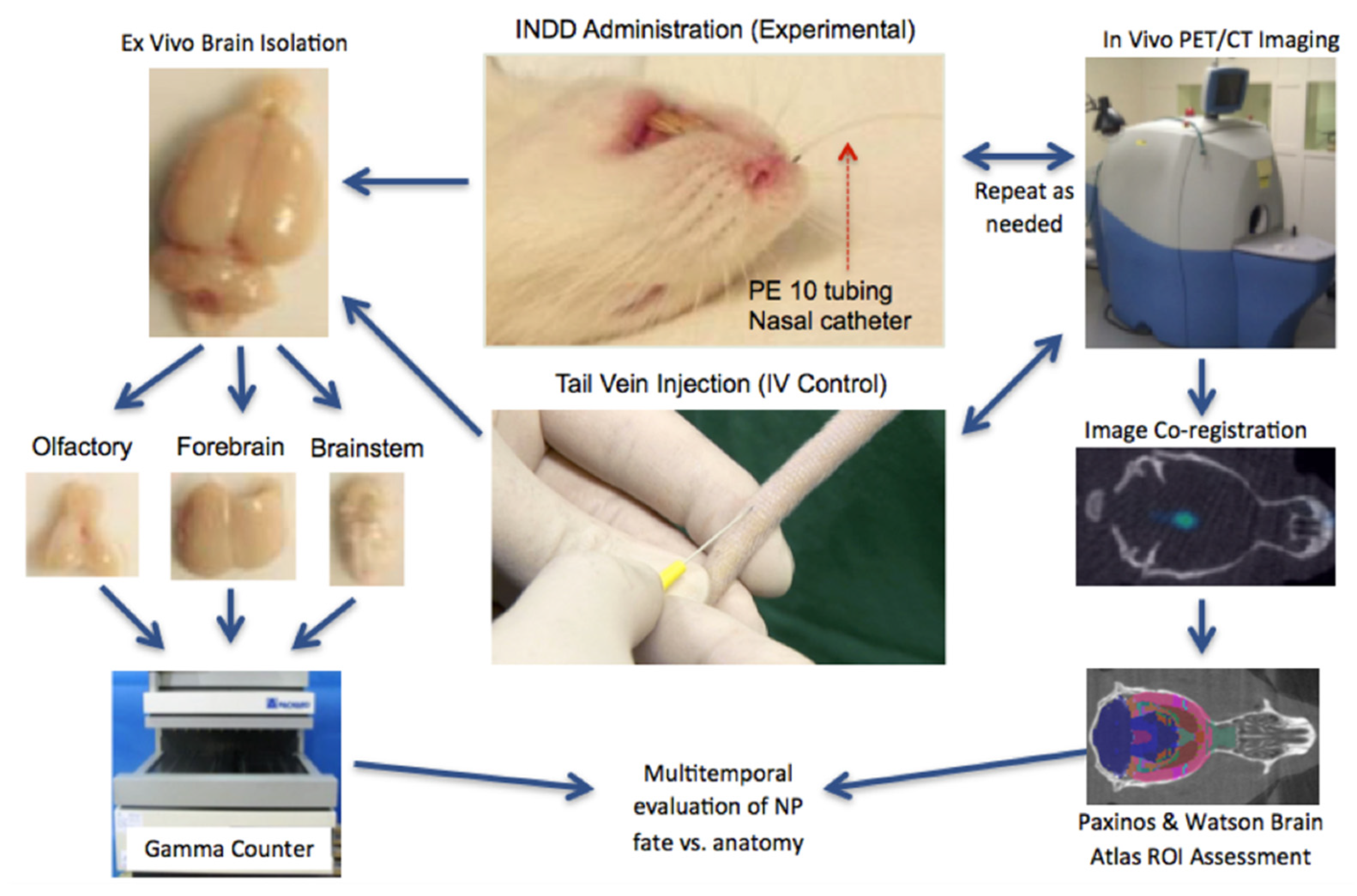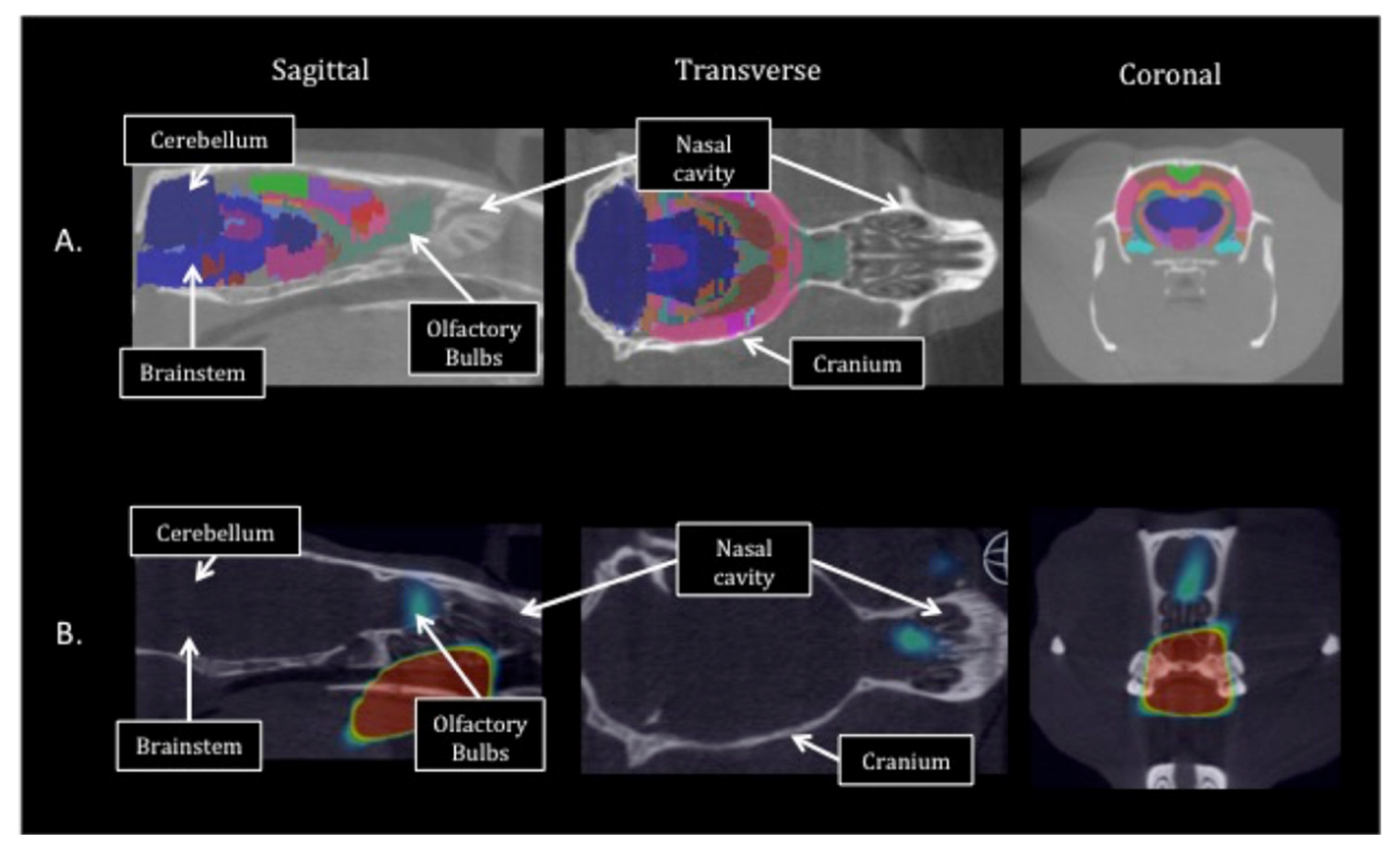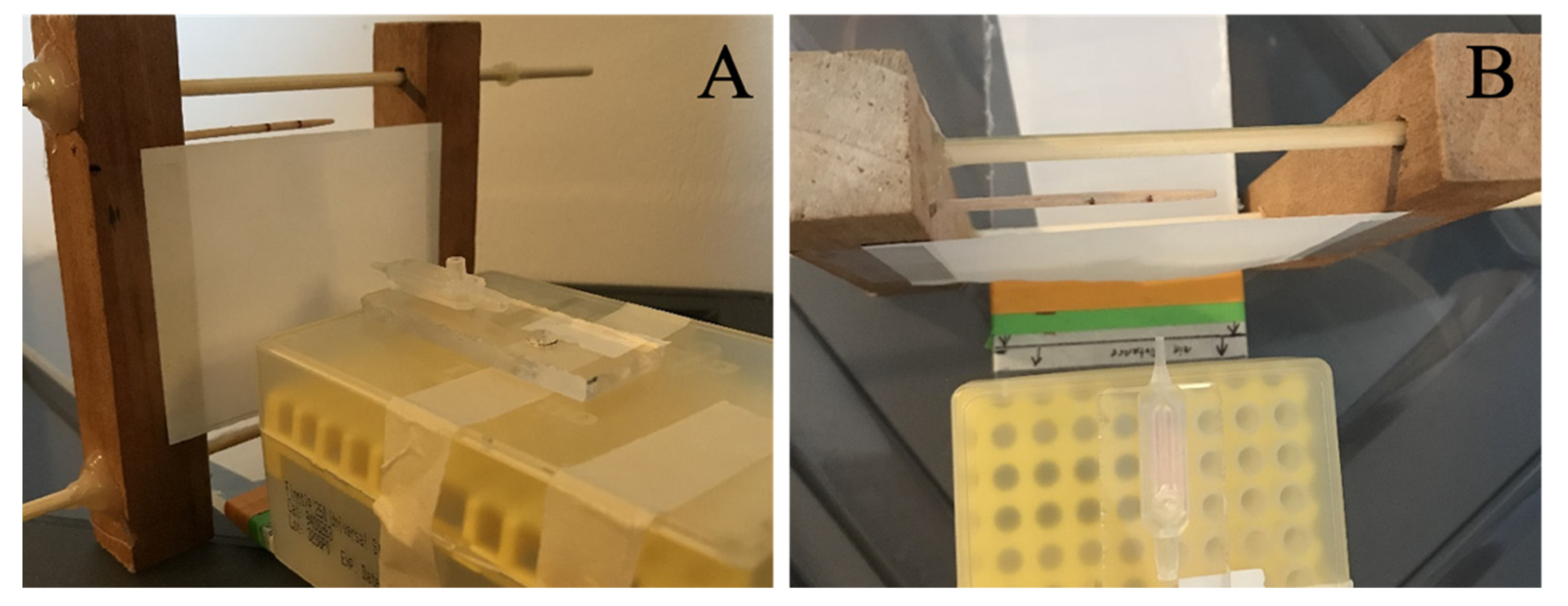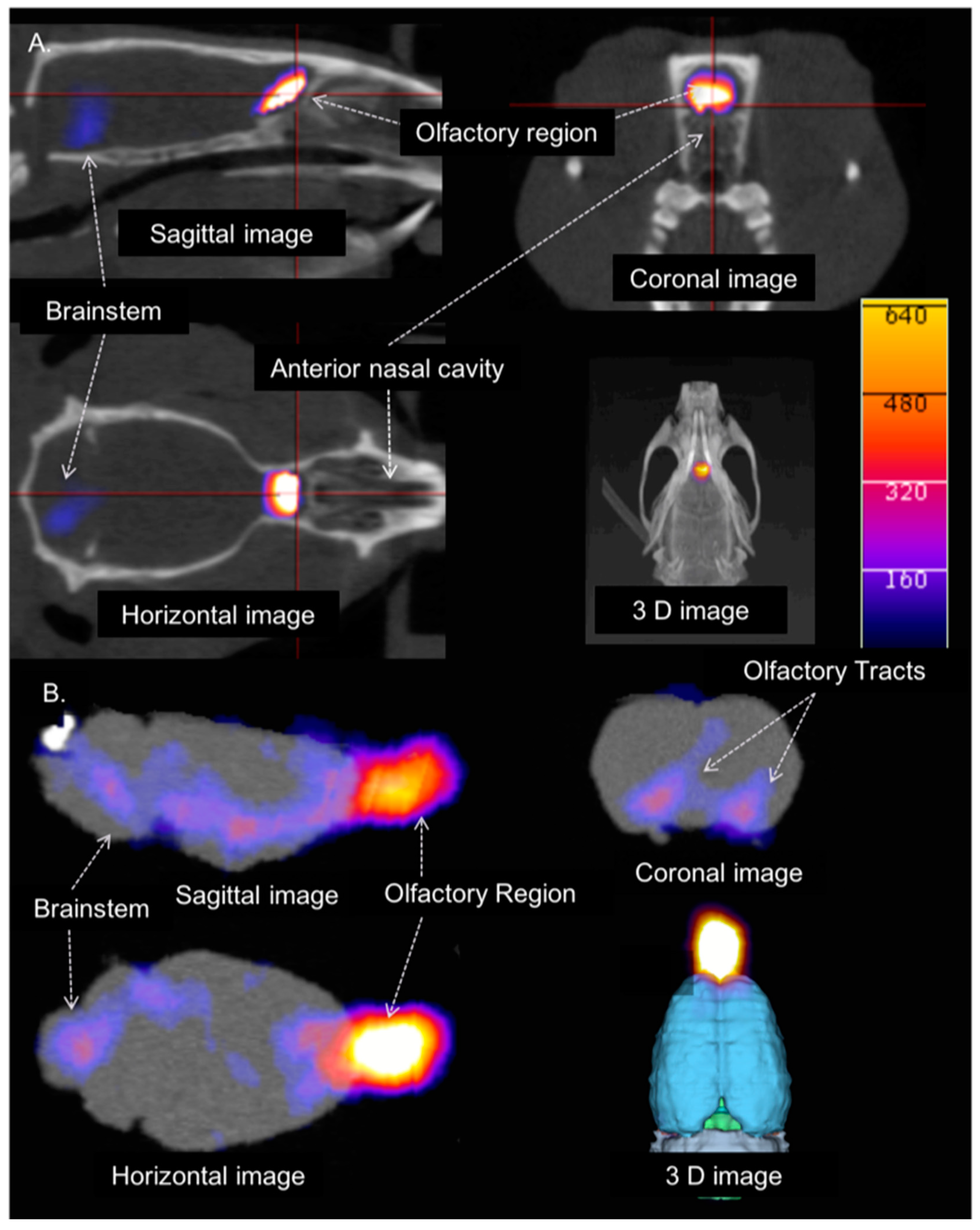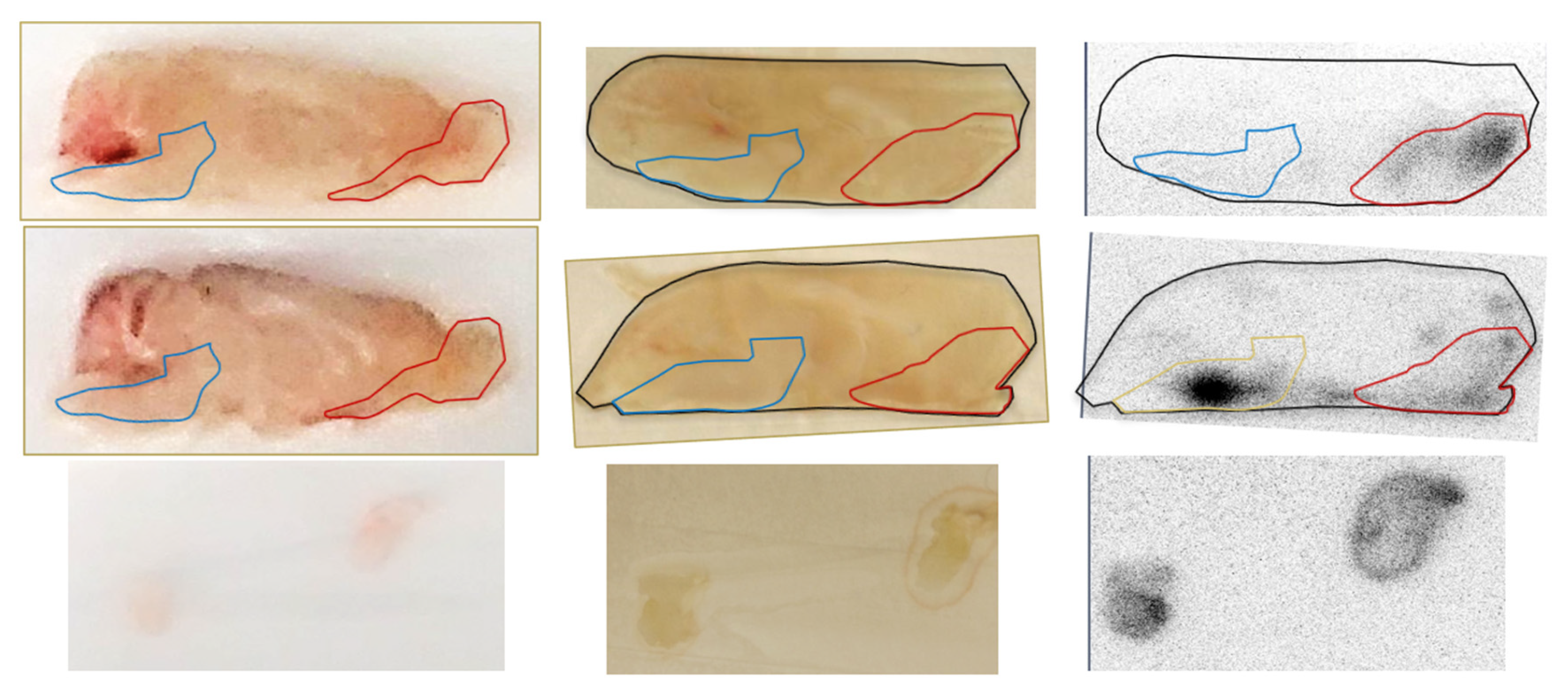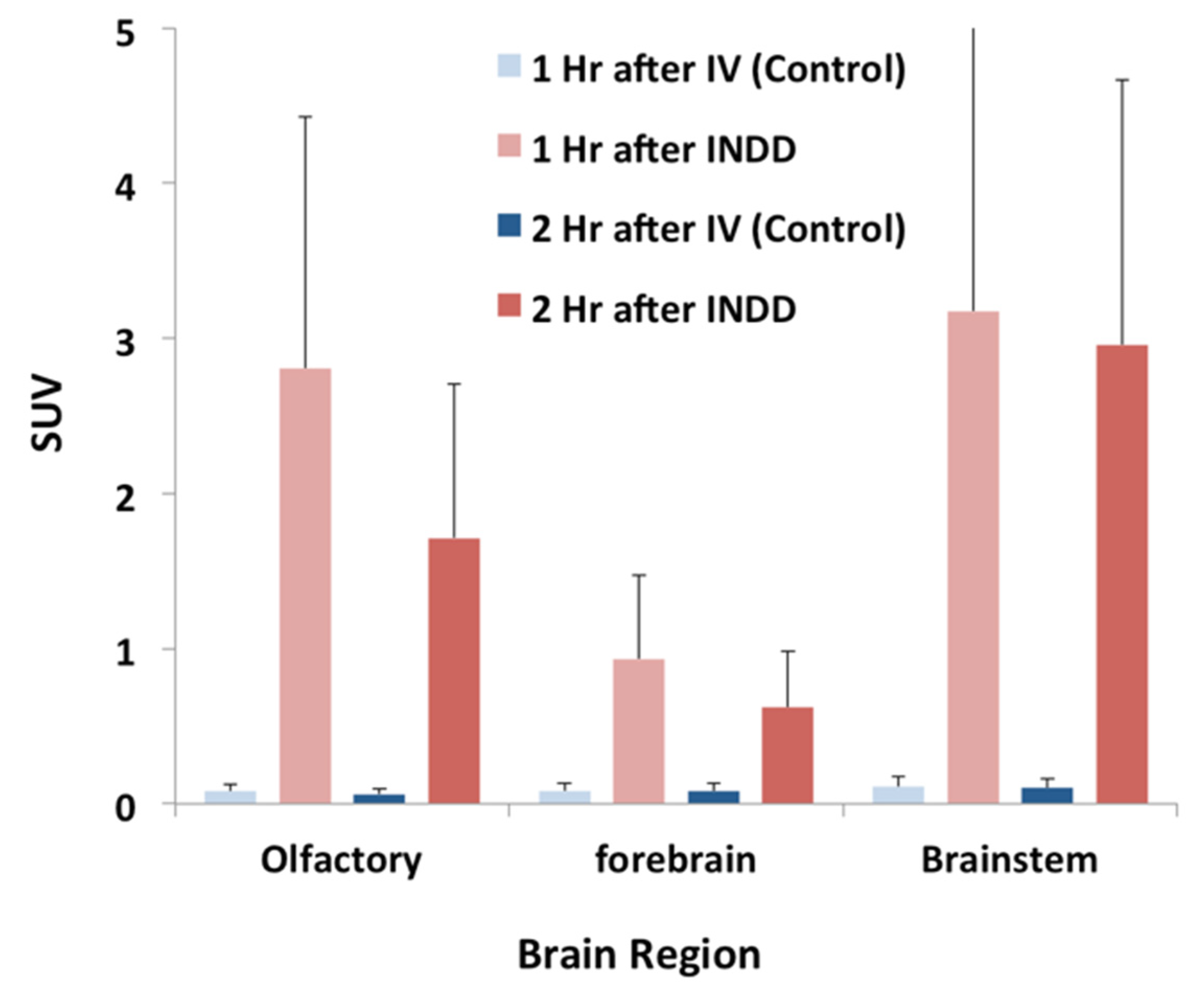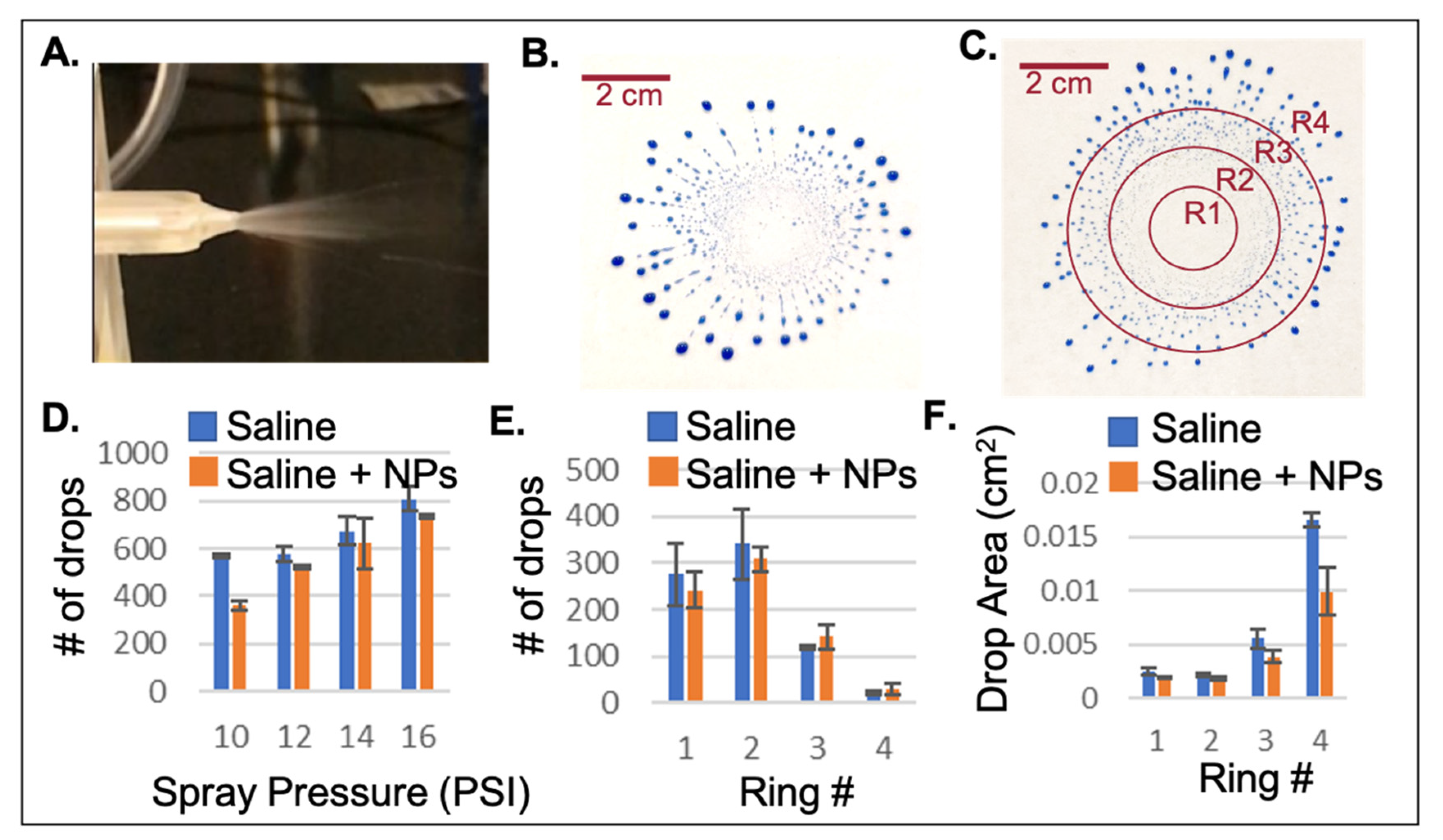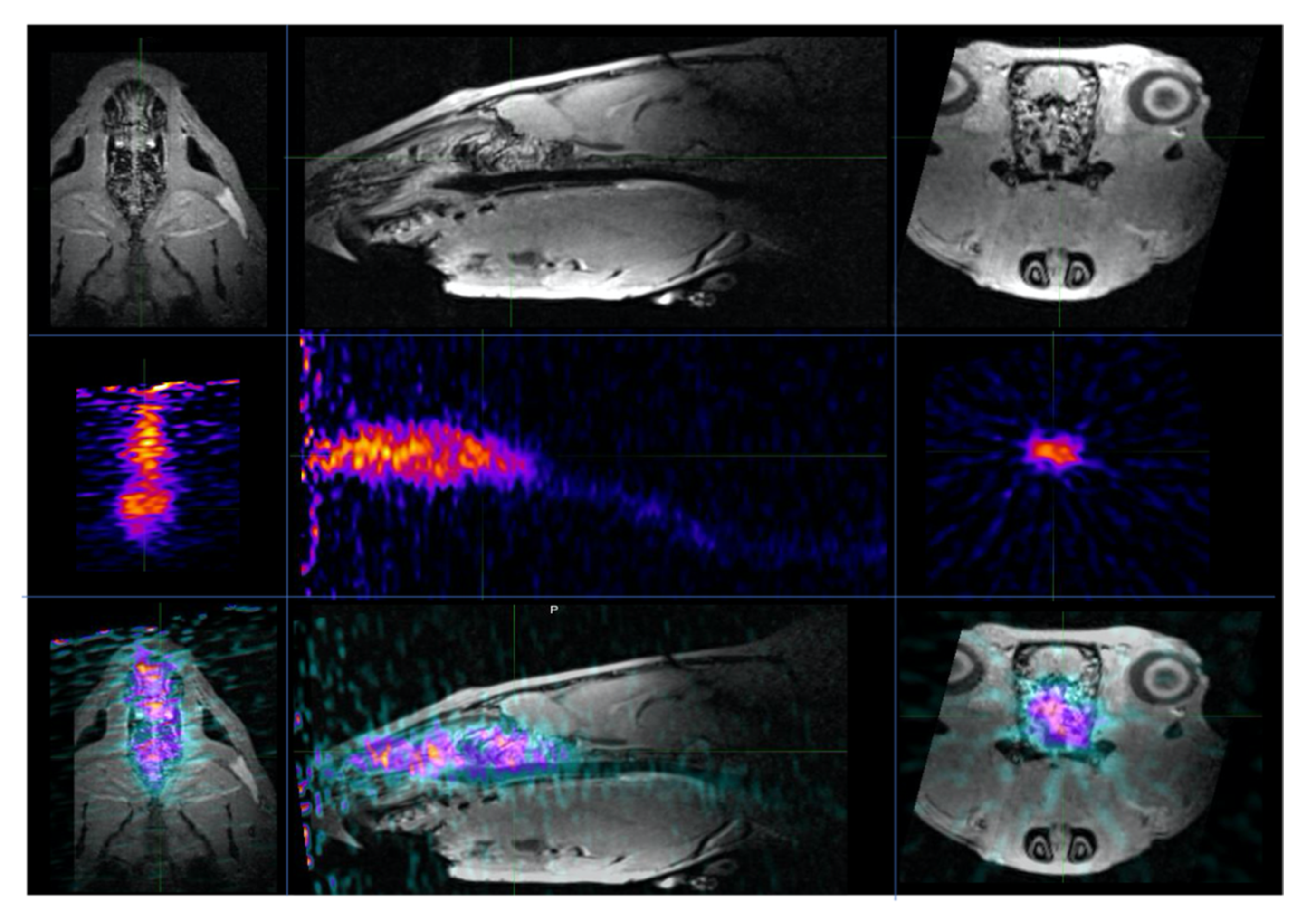1. Introduction
Central nervous system (CNS) disorders are often difficult to treat, since many drugs are unable to cross the blood–brain barrier (BBB) [
1]. It is projected that ≈100% of large-molecule neurotherapeutics and more than 98% of all small-molecule drugs are effectively inhibited by the BBB [
2]. Understanding the mechanism of the delivery and the fate of drugs that can bypass the BBB is an imperative first step in developing viable drug therapies for CNS diseases [
3].
Theranostics is a fast-emerging field with the potential to assist with overcoming challenges associated with drug delivery to the CNS. Theranostics merges the potential of the radiological sciences with the delivery of therapeutic agents, thereby promising to advance the goals of personalized medicine [
4]. One important aspect of theranostics is that it utilizes multifunctional nanocarriers, which enables simultaneous molecular imaging and targeted therapy delivery by combining a therapeutic drug with an imaging label. Among these nanocarrier agents are biodegradable polymers with acceptable toxicity profiles, biocompatibility, and non-immunogenicity [
5]. Polylactide (PLA), polyglycolide (PGA), and polylactide-co-glycolide (PLGA) nanoparticles (NPs) have been the most extensively investigated for drug delivery [
6].
Intranasal drug delivery (INDD) is an attractive alternate strategy for circumventing the BBB for local drug delivery to the CNS. It is relatively non-invasive, it avoids first-pass metabolism, and side effects can be minimized because only very small drug concentrations may be needed for treatment. Due to its non-invasive nature, there are reduced risks of infection and disease transmission. Nasal spray formulations are easy to administer and can be performed at home by the patient. Following intranasal delivery, nanocarriers enter the CNS via transcellular and intercellular routes and gain access to the perineural and perivascular fluid channels surrounding the olfactory and trigeminal nerves [
7]. Nose-to-brain (N2B) transport may bypass the BBB and provide a conduit for the entry of drugs into the brain [
8,
9]. The anatomical and cellular structures of the nasal cavity were recently reviewed with tabulation of advantages and limitations for nose to brain delivery [
10].
Most CNS drug delivery research involves sacrificing experimental animals and measuring tissue levels using autoradiography, gamma tracer counting, high performance liquid chromatography, and histology, although in vivo imaging of intranasal delivery in both animals and humans is increasing [
11]. We chose to focus on positron emission tomography (PET) imaging combined with computer tomography (CT) because of its superior sensitivity and good anatomical detail. Gamma counting was utilized as a reference point for comparison ex vivo.
Aerosolized intranasal drug delivery to target the dorsal nasal cavity in small animals is not a novel concept. However, it is difficult to perform in a reproducible manner in rodents, given their small size and intricate nasal anatomy. A better understanding of intranasal drug delivery in a living animal model will be critical for increasing the translation of drugs to the clinic for nose-to-brain delivery. Herein, we delineate the challenges associated with preclinical small animal aerosolized drug delivery and outline a strategy for improving intranasal delivery using multimodality in vivo imaging.
The purpose of this study was two-fold: (1) To establish the feasibility of preclinical multimodality imaging for intranasal polymeric NP administration via nasal tubing, and (2) to develop a strategy for implementing aerosolized intranasal delivery as an improvement over intranasal delivery via saline tubing.
4. Discussion
Imaging of the INDD-administered nanoparticles (100 nm PLA–PEG–
89Zr NPs) demonstrated greater activity in the brain after INDD compared to IV delivery (1 and 2 h after treatment). IV administration was used for comparison, since this route labels the blood pool and provides prolonged exposure of the blood–brain barrier. Increased activity in the brain after INDD compared to IV delivery is in keeping with previous reports, especially that of Kozlovskaya et al. in 2014 [
18]. We observed much higher levels of activity in the olfactory region and brainstem compared to the forebrain after INDD, suggesting that the NPs entered the brain through the olfactory and trigeminal pathways, as the forebrain is more distal with respect to these two points of entry into the brain. The specific route of administration (whether transneuronal, transcellular, intercellular, or perineural/perivascular) remains unknown. However, the rapid appearance in the brain within 1 h suggests that bulk convection flow through the perineural/perivascular route is a likely contributor.
We cannot say with certainty whether the signal arising from the brain was within the intracellular or extracellular space/cerebrospinal (CSF) spaces, or even partially within the blood pool. However, we did perform intra-cardiac saline perfusion through the left ventricle until the return from the right atrium was clear, indicating removal of the majority of the blood from the intravascular space. During brain isolation, we dissected specific regions of tissue to minimize the contribution from the CSF spaces. Nevertheless, the CSF spaces were too small to discern with the unaided eye. For instance, there is an olfactory cistern coursing through the middle of each olfactory bulb, but the diameter of this CSF space is very small compared to the total volume of brain tissue dissected and analyzed. In the future, we will isolate blood during the intra-cardiac perfusion and assess it with a gamma counter to determine whether there is a contribution of activity from the brain’s intracranial circulation. We will also employ a method of collecting CSF from rats via access to the cisterna magna using the technique developed by Nirogi et al. in 2009 [
19]. This is a technically demanding, but important question to answer in future experiments.
Independent verification of the PET/CT imaging findings was provided by gamma counter readings, with which the activity in the brain from the
89Zr radiolabeling was greater in the intranasally exposed compared to IV-injected animals. This observation suggests that advanced imaging may be useful for understanding how best to administer, track, develop, and understand the in vivo behavior of NP agents in the CNS. A clear increase in brain activity occurred, as assessed with the gamma counter from 1 h to 2 h. Although the activity in the brain following INDD was increased in the PET results compared to following IV administration, the difference in activity between the 1 and 2 h time points by PET could not be ascertained following INDD within the current sample size. This may be from the lower sensitivity of PET relative to gamma counting. Unlike in the gamma studies (where we removed the brain from the skull and separated the brain from the nasal cavity and oropharynx), we were not able to completely eliminate the possibility that the higher signal activity seen in the olfactory bulb and brainstem in the in vivo studies was at least partially because of the high activity coming from the adjacent nasal cavity (for the olfactory bulb) and oropharynx (for the brainstem). This may also explain the lower values in the olfactory bulb relative to the brain stem on PET, yet higher values in the olfactory bulb compared to brain stem gamma counting results. The mean beta annihilation range in water for
89Zr can occur up to 1.34 mm from the actual location of the tracer [
20]; thus, not all of the signal in the brain next to the nasal cavity and oropharynx, namely, the olfactory region, can be assured as having arisen from within the brain parenchyma. That limits full quantitation in these regions.
The issue of signal spillover (scatter artifact) from the nasal cavity is a very important issue. There is an inherent limitation to the spatial resolution in PET imaging that will make accurate quantitation of signal at the cribriform plate difficult. On the contrary, it has been known for some time that substances flow between the nasal cavity and the brain peri-/para-vascular spaces, especially at the base of the brain. This might perhaps be viewed more as a continuum through the porous cribriform plate rather than an actual bony barrier physically separating these two compartments. The brain’s ventricular system and subarachnoid spaces are also in communication with the peri-/para-vascular spaces (and hence the nasal cavity). Items injected into the ventricles will subsequently be detected in the nasal cavity and from there travel as distally as the neck [
21]. In a study by Bedussi et al. in 2015, dyes injected into the brain parenchyma (striatum) and cisterna magna were also found to be in continuum with the extracellular spaces, basilar cisterns, and nasal cavity [
22]. This may also explain the observation that although the NPs were instilled in a single nasal cavity, the signal was visible roughly equally in both olfactory bulb regions, although the possibility that this can be explained by spillover cannot be excluded. Future studies will assess for the presence of nanoparticles in the olfactory tissue using transmission electron microscopy to validate entry of the NPs into the brain and to exclude the possibility that the signal merely represents the radiotracer signal. Regardless, to the best of our knowledge, there are no preclinical studies that have utilized highly sensitive PET/CT dual modality imaging to assess nose-to-brain delivery in a living animal.
Interestingly, we observed greater activity in the brain stem relative to the olfactory region using PET at both time points (
Figure 7). This pattern was reversed in the gamma counter studies, where the signal in the olfactory bulbs was higher than that in the brain stem at 1 and 2 h post-treatment (
Figure 8). We believe this may reflect the importance of distributing the nanoparticles uniformly in the dorsal superior nasal cavity, which we propose would be an added benefit of aerosolized intranasal delivery over liquid solution delivery through nasal tubing. This finding also points to the importance of understanding and optimizing the adhesion of drugs or NPs within the nasal cavity, which in turn increases retention and absorption [
23]. This variability in uptake of the olfactory bulb relative to the brain stem was also demonstrated in the autoradiography study (
Figure 6), where one rat had greater uptake in the nasal cavity, and the other had stronger uptake in the brainstem.
Numerous publications have demonstrated quantitative intranasal delivery to the olfactory region, brainstem, and deeper brain regions in an ex vivo manner without the use of dynamic imaging (see reviews by Lochhead et al. in 2012 [
7] and Kozlovskaya et al. in 2014 [
18]). A few studies have shown initial imaging in living animals, mostly using gamma scintigraphy [
24]. However, direct visualization of the activity in the brain in all of these studies was limited by the lack of three-dimensional cross-sectional anatomic correlates. While we are able to demonstrate a differential uptake of activity in the brain after INDD compared to IV administration, we did not perform an area under the curve assessment to determine the direct targeting efficiency, which is becoming the standard of quantitative nose-to-brain drug delivery. This will be adapted in future work with validation studies over longer periods of time.
Since our goal was to establish the feasibility of multimodality INDD imaging of NPs, we chose to image the rats at 1 and 2 h post-administration. The data acquisition times used for this set of experiments were prolonged and not ideal for kinetics faster than the first 30 min following INDD. An additional rationale for the imaging sampling times was based on the work of Born et al. in 2002, a frequently cited human clinical study highlighting a nose-to-brain pathway [
25]. Three clinically relevant peptides, namely, melanocortin(4–10) (MSH/ACTH(4–10)), vasopressin, and insulin, were delivered intranasally, followed by CSF detection via an intrathecal catheter. These were compared against an intranasally delivered placebo treatment. Although the detected levels of the three peptides were increased compared to baseline in the CSF as early as 10 min after INDD, it took between 30 and 80 min to reach significantly increased concentrations above baseline. The concentrations of MSH/ACTH(4–10) and vasopressin were still above those in the placebo-treated subjects at 100–120 min after administration. More recently, intranasal oxytocin administration was not detected in significant enough amounts compared to IV delivery until 75 min after INDD [
26]. While CSF detection does not imply delivery to the brain parenchyma, it is an indication that it takes at least this long for the drug compounds to reach the brain tissue via the perineuronal/perivascular/subarachnoid spaces. In other animal studies, estimates of peak brain delivery following INDD (including nanoparticles) range between 20 and 60 min to reach the olfactory bulb and between 1 and 4 h to reach the other brain regions (including the brainstem) [
7].
It is ubiquitous in the literature that a percentage of nasally delivered nanoparticles in a liquid solution will inevitably be swallowed, since ciliary motion sweeps substances out of the nasal cavity and toward the oropharynx. This was also found to be the case in our initial aerosolized delivery assessment with
89Zr. We performed whole body ex vivo biodistribution studies using a human clinical PET/CT scanner following both INDD and IV delivery of the same 100 nm PLA–DSPE–PEG NPs at 30 min and 1 h [
27]. As expected, the gastrointestinal tract accounted for a major fraction of the nanoparticles’ localization after being swallowed, and only a small fraction of the nanoparticles could be seen in the brain. Subregional brain delivery was not assessed, since we needed to use a clinical PET/CT scanner to assess the full body biodistribution. A more clinically relevant way to deliver drugs/NPs intranasally would be to use an intranasal aerosolizer rather than a liquid solution in tubing administered through a syringe. According to Piazza et al. [
16], the use of aerosolized NPs could increase the amount of NPs that bind to the nasal epithelium via improved nasal cavity mucosal surface coverage, increased state of dispersion, and enhanced impact force of NP–epithelium collisions. This would aid in the capture and subsequent transport of NPs by and then through the mucosal layer. The end result of the greater transnasal absorption would be a reduction in the loss of NPs into the respiratory or gastrointestinal tracts.
This study has several limitations that need to be considered. First, the sample size was small, so future experiments with variations in the type of NPs, doses, and administration methods (such as aerosol spray) will expand our knowledge base. Second, complex multifunctional NPs are subject to metabolic processes that may alter their compositions and separate their component parts. Third, our experiments were limited to PET/CT with gamma counter validation. Additional modalities are available that can be used to explain various aspects of nanoparticle fate, including MRI and optical fluorescence. Fourth, the time course of our study was limited to 2 h, so this limited time scale cannot fully assess NP pharmacokinetics in the CNS. Fifth, there was no histological confirmation or autoradiographic evidence to show the fate of the NPs at a cellular level. The characterization of NPs, especially if intended for ultimate human use, is a complex, technically demanding, and rapidly maturing specialty area. Our NPs received a limited laboratory characterization that must be augmented with comprehensive distribution, metabolism, and toxicological data to more fully understand the biological behavior of the agent. Finally, we did not attempt to show any direct drug effect associated with INDD, but instead limited our attention to the short-term distribution of NPs and to a feasibility demonstration of imaging in the administration phase. Our future work is intended to more thoroughly evaluate the NPs and their mechanism of transport, their time course, and their fate using PET/CT; to establish improvements in image post-processing; and to test other imaging modalities with detailed independent validation of imaging findings.
In conclusion, we demonstrated that radiolabeled NPs administered intranasally via liquid form in nasal tubing can enter the brain with a sufficient concentration to be detected by PET/CT imaging within 1 h, validated using tissue dissection and a gamma counter. These findings indicate that the fate of radiolabeled NPs administered via the intranasal route can be determined with PET/CT imaging in experimental animals (rats). We proposed an improvement on nasal tubing intranasal delivery via a recently developed promising rat aerosolized delivery protocol, but further studies are needed to demonstrate superiority of aerosolized delivery over nasal tubing delivery.
